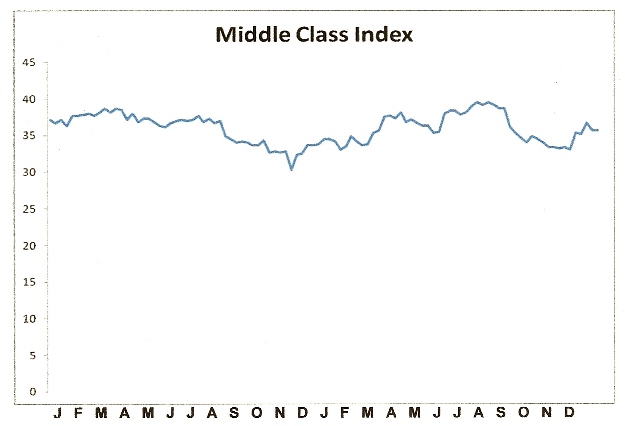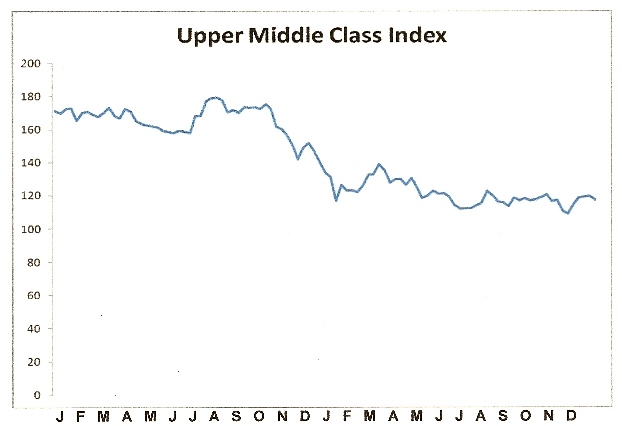With the U.S. presidential election now behind us, many investors feel they can finally breathe easy again after a nail-biting period of uncertainty since last year. The rally in the major equity market indices since Nov. 9 has been, in large part, a relief rally of sorts and has been broad-based. The sell-off in bonds has also been an indication of this collective relief.
Despite the powerful stock market rally, not everyone is relieved about the election’s outcome. There is some evidence that a large segment of the U.S. population is still feeling uneasy about the incoming president. I’m referring specifically to the upper-middle class, which by some measures hasn’t expressed any enthusiasm in the way of increased spending patterns since the election. Indeed, many in this socio-economic group have expressed an unwillingness to make major purchases until they see evidence that President-elect Trump’s policies are beneficial for the economy.
The upper-middle class is roughly defined as those individuals that earn from around US$85,000 to $150,000 per year. Based on one measure of upper-middle class retail spending, they’ve noticeably curtailed their discretionary spending for at least the last two years. Middle class spending also remains below its 2014 peak.
Here’s a theoretical question: If it were possible to invest in either the middle class or the upper-middle class as if both were individual stocks or ETFs, which would you choose? Logic would dictate the latter group since we are assured by economists that the upper-middle class has actually grown in recent years while the middle class has allegedly shrunk. Moreover, upper-middle class members typically earn on average at least twice as much as the middle class average income. So given a choice between the two, which do you think has performed better in the last couple of years?
The answer will no doubt surprise many of you; it’s the middle class. Here’s what a middle class “ETF” would look like:

This theoretical class index is comprised of several companies which cater mainly to the middle class, including WalMart, Dollar General, McDonalds, Ford, and JC Penny. Notice in the above chart that while most of the middle class-oriented stocks peaked in 2014, many of these stocks have actually held their own and have been trending more or less sideways since last year. Some of them have even shown an upward bias since this year.
Now for the upper-middle class “ETF.” Here’s the chart:

As you can see, the upper-middle class hasn’t exactly felt ebullient since their discretionary spending peaked in 2014. This index is comprised of stocks which cater mainly to members of the upper-middle, including Target, Starbucks, BMW, Whole Foods, Apple, and Chipotle Mexican Grill. Evidently, the upper-middle class has felt less than enthusiastic in the last two years, as the overall trajectory of most publicly traded companies who serve this sector has been, surprisingly, downward trending.
This is not to imply that the fortunes of the upper-middle have been declining; economic statistics suggest the opposite. Yet a distinction must be made when performing this type of analysis between havingmoney and the willingness to spend it. Clearly the upper-middle class has been, by and large, less willing to spend than in the years prior to 2015.
It would be tempting to lump the trends shown in the above charts together and label them collectively as a great “middle class revolt.” Undoubtedly that could be said about the way the middle class feels, for they made their grievances known in the recent election. As I’ve demonstrated many times in the past, nothing is more devastating to the mass psyche than a prolonged sideways trend in the equities market. The directionless stock market trend visible in the NYSE Composite Index since 2014 is a case in point. I believe that this, more than perhaps any other factor, has engendered the spirit of revolt among the middle class.

Human nature is so constituted that if progress isn’t evident over a certain period of time, people become restless. The longer that people feel they aren’t progressing, the more restless they become. This explains why, almost without exception, every political or military revolution in industrialized countries occurs after a prolonged trading range in that country’s equity market. In the case of the U.S. middle class, it’s not that this class is actually getting poorer; rather, they only feel they’re not progressing. The above middle class “ETF” chart only serves to underscore that belief.
I would also make one more observation about both the above mentioned “ETFs.” The middle class and upper-middle class charts suggest that investors in both classes have been underperforming the major averages. Perhaps this is another factor behind the widespread notion that the middle class is “shrinking.” While their collective earnings have either stayed the same or increased in recent years, their potential earnings (via the investment markets) have declined. This can only feed into the growing sense of disillusionment that many within the middle class are feeling. What comes as a surprise, however, is that the same might also be said of the upper-middle class.
The next few months will be extremely interesting from the standpoint of middle class investor sentiment. Should the middle class index fail to break out from its 2+ year trading range soon, the middle class may show further signs of discontent next year – especially if President Trump fails to deliver on his promises to the middle class.
Moreover, a failure of the upper-middle class index to significantly reverse its downward trend fairly soon could potentially cause problems with the broader economy given their outsized impact on consumer spending. Needless to say, the next few months will be very informative on a number of levels.
Mastering Moving Averages
The moving average is one of the most versatile of all trading tools and should be a part of every investor’s arsenal. Far more than a simple trend line, it’s a dynamic momentum indicator as well as a means of identifying support and resistance across variable time frames. It can also be used in place of an overbought/oversold oscillator when used in relationship to the price of the stock or ETF you’re trading in.
